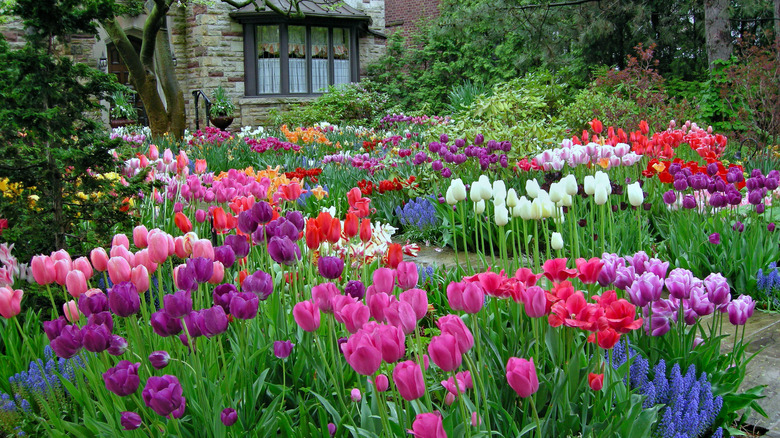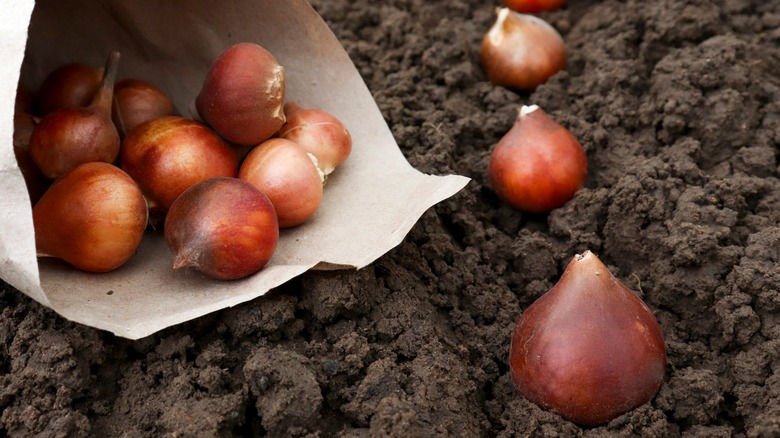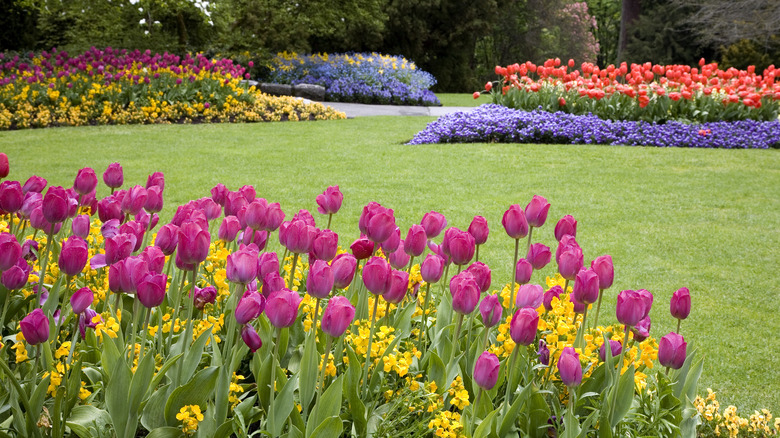The Best Spot In Your Garden To Plant Tulips
Tulips are a staple of spring. Likely, you've already seen many sprouting up in your neighbors' yards and other places around town. This early in spring, they are just starting to show their brightly colored, tight heads in oranges, yellows, pinks, white, and more. As we creep into the later months toward summer, they will open slightly to create their well-known and full display. If you've been admiring others' tulip plantings, or having trouble with your own, you might be wondering where is the best spot to plant your next round come autumn.
Most spring bulbs, including tulips, perform best when they are planted in bright sunlight. In general, you want your tulip bulbs to receive a minimum of six hours of direct sun per day in order to maximize their blooms. In a cool climate, planting tulips in even a little bit of shade could cause them to produce more leaves and fewer flowers. Although, many of them can withstand a slightly shady location if you live in a hot climate farther south. So, when choosing the best place to plant yours, first consider the sunniest areas in your garden.
The soil conditions tulips need
Once you've identified the perfect sunny spot for your tulip bulbs, you'll need to take a look at the soil. These classic flowers enjoy crumbly soil that is loose and not too wet. Typically, they grow well in sand and other workable mediums. Be certain that you aren't picking a spot that rainwater drains into as this will quickly lead to rotting tulip bulbs and a waste of your effort.
Additionally, the temperature of the soil is just as important as the texture. Spring-flowering bulbs must be exposed to a couple of weeks, if not months, of cold weather if they are to grow properly. This is why seasoned gardeners plant their tulip bulbs just as the summer comes to an end and soil temperatures are close to 60 degrees Fahrenheit. Through the winter, the ground will become even colder which prepares the bulbs for blooming in the spring. You can choose to bury yours even later in the fall or winter. As a rule of thumb, if the ground isn't yet frozen, it's not too late to plant.
How the spot you choose can change your landscape
There are different arrangements in which you can plant tulips and each of them will beautifully transform the aesthetic of your lawn. One option is mass planting. Many people love the look of a flower field in full bloom and tulips are great for this. With 50 or more tulip bulbs you can space your flowers with only a few inches between them for a large floral display that's full of color. If you plan to do it this way, you'll need to pick out a large section of land that can support all the flowers with plenty of sunlight.
If you don't want to buy so many of the bulbs, interplanting tulips with foliage-filled or long-blooming perennials also keeps the color going all season long. Alternatively, intersperse bulbs throughout low-growing ground cover plants like creeping jenny, periwinkle, or creeping phlox, so the ground doesn't look bare when the flowers aren't in bloom. Choosing distinct tulip varieties with varying bloom times can also keep your garden looking fuller longer. Depending on the cultivars you pick, you may be able to boast blooming tulips in your yard for over a month. Keep in mind that nearly all tulip species are susceptible to a range of diseases that can wipe out your bulbs and contaminate your garden. Because of this, it's wise to rotate your planting areas every three years or so to allow the soil to rest.


